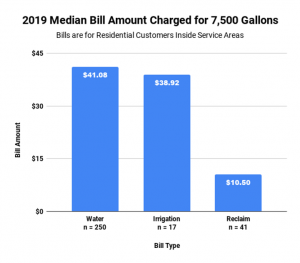Written by Ashley Bleggi
As far back as 1926, Arizona has been a leader in the ever evolving world of water reuse. With the release of the 2019 Arizona Water and Wastewater Rates Dashboard, we want to take a look at the recent insights our surveys have uncovered, as well as the current state of reclaimed water legislation in Arizona.
Overall, about 15% of all the utilities we surveyed for 2019 provide reclaimed water. As discussed in the EFC’s 2017 Arizona Water & Wastewater Rates Report , reclaimed water is significantly cheaper to produce and sell in part due to low energy requirements. Investing in reclaimed water processes allows utilities to avoid the costs of transporting wastewater long distances to surface discharge points, or investing in costly groundwater recharge infrastructure. This trend of reclaimed rates low comparative cost continues into 2019 with the data below showing reclaimed water bills to be nearly four times cheaper than both water and irrigation charges at the same 7.5 kgal consumption level.

According to a recent publication in The National Academies Press, “non-potable uses of reclaimed water (e.g., irrigation, industrial) require a quality of water that is not much different than what a typical secondary or advanced wastewater treatment plant would produce.” Utilities with existing wastewater treatment infrastructure may require little investment to adapt to providing reclaimed water. For utilities interested in expanding their portfolios, adding a new revenue stream, and decreasing energy costs of wastewater treatment over time, providing effluent water to their customers could be a natural next step.
At the time of the 2017 Arizona Water and Wastewater Rates survey, treated wastewater was legally non-potable, but as advanced technologies like nanofiltration, and reverse osmosis, have become better and more reliable, Arizona has expanded the legislation to include direct potable reuse (DPR).
The Arizona Department of Environmental Quality (ADEQ) has held legislative authority for water reuse since 1999. In 2001, they updated regulations allowing for safe, indirect use of recycled water. Effective January 1, 2018, utilities were newly able to apply for advanced reclaimed water treatment facilities for DPR; however, these new regulations did not overrule past decisions on applications for water treatment methods. ADEQ is currently developing more detailed regulations for the treatment and distribution of potable treated wastewater. In response to the changing laws, the National Water Research Institute published the Guidance Framework for Direct Potable Reuse in Arizona sponsored by WateReuse Arizona and AZ Water Association. This framework is designed to help Arizona utilities understand not only the process of modern DPR possibilities and regulations, but also the reasoning and motivation behind the need for such modern legislation.
The Environmental Finance Center has partnered with the Water Infrastructure Finance Authority of Arizona (WIFA) to create the Arizona Water and Wastewater Rates Dashboard as well as tables and reports detailing our findings since 2014. The increased enthusiasm for incorporating effluent as an option for many customers across Arizona shows the ingenuity and adaptability of the state year after year. Read more about the current trends in Arizona water and wastewater in our 2019 summary report.
Ashley Bleggi graduated from the University of North Carolina at Chapel Hill with an Economics major and a Statistics and Analytics/Mathematical Decision Sciences minor, and worked at the EFC at UNC as a Rates Specialist. She previously worked with the Statistics department at UNC Chapel Hill and is passionate about promoting accessibility and usage of real world data for the general public from a local level.

